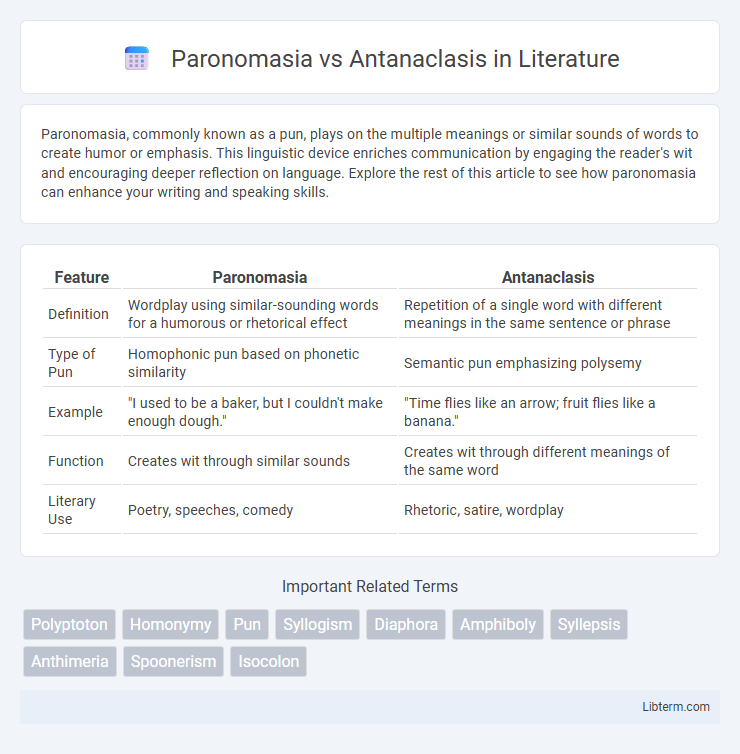Paronomasia, commonly known as a pun, plays on the multiple meanings or similar sounds of words to create humor or emphasis. This linguistic device enriches communication by engaging the reader's wit and encouraging deeper reflection on language. Explore the rest of this article to see how paronomasia can enhance your writing and speaking skills.
Table of Comparison
| Feature | Paronomasia | Antanaclasis |
|---|---|---|
| Definition | Wordplay using similar-sounding words for a humorous or rhetorical effect | Repetition of a single word with different meanings in the same sentence or phrase |
| Type of Pun | Homophonic pun based on phonetic similarity | Semantic pun emphasizing polysemy |
| Example | "I used to be a baker, but I couldn't make enough dough." | "Time flies like an arrow; fruit flies like a banana." |
| Function | Creates wit through similar sounds | Creates wit through different meanings of the same word |
| Literary Use | Poetry, speeches, comedy | Rhetoric, satire, wordplay |
Introduction to Paronomasia and Antanaclasis
Paronomasia is a rhetorical device that exploits the similarity in sound between words to create a playful or humorous effect, often through puns. Antanaclasis, a specific type of paronomasia, involves repeating a word within a sentence but altering its meaning each time. Both techniques enrich language by leveraging phonetic similarity and semantic variation to enhance expression and wit.
Defining Paronomasia: The Art of Wordplay
Paronomasia, a sophisticated form of wordplay, exploits the similarity in sound between words to create a witty or humorous effect, often found in puns and rhetorical expressions. It differs from antanaclasis, which repeats the same word with a different meaning, by relying on homophones or near-homophones for its semantic twist. Mastery of paronomasia enhances linguistic creativity, enriching literature, advertising, and everyday communication with playful ambiguity.
Understanding Antanaclasis: Repetition with a Twist
Antanaclasis is a rhetorical device involving the repetition of a word or phrase with a shift in meaning, creating a play on words that enhances humor or emphasis. Unlike paronomasia, which relies on word similarity or sound to generate puns, antanaclasis leverages the same word in different contexts to deliver a twist. This technique is often used in literature, advertising, and speeches to engage audiences through clever linguistic variation.
Historical Origins and Literary Evolution
Paronomasia, rooted in ancient Greek rhetoric, emerged as a favored device in classical literature to create wordplay through phonetic similarity for humorous or rhetorical effect. Antanaclasis, a subset of paronomasia, specifically involves the repetition of a word within a sentence but with different meanings, tracing its usage back to illustrations by Aristotle and prominence in Renaissance literature. Over centuries, both techniques evolved within various literary traditions, shaping stylistic developments in poetry, drama, and oratory by emphasizing ambiguity and semantic richness.
Key Differences Between Paronomasia and Antanaclasis
Paronomasia involves wordplay using similar-sounding words with different meanings to create a pun, emphasizing phonetic similarity. Antanaclasis, a specific type of paronomasia, repeats the same word but shifts its meaning within the context, highlighting semantic contrast. The key difference lies in paronomasia's reliance on homophones or near-homophones, whereas antanaclasis focuses on the repeated word's varying interpretations.
Classic Examples in Literature and Rhetoric
Paronomasia and antanaclasis are classical rhetorical devices used to create wordplay through similar sounds or repeated words with different meanings, often enriching literary texts. Classic examples include Shakespeare's use of paronomasia in "Romeo and Juliet," where the word "sole" is played upon, and antanaclasis in Benjamin Franklin's phrase, "We must all hang together, or assuredly we shall all hang separately," utilizing the same word "hang" with varied meanings. These devices enhance the persuasive power and memorability of rhetoric by exploiting linguistic ambiguity and phonetic resemblance.
Functions and Effects in Communication
Paronomasia enhances communication by creating playful ambiguity through the use of similar-sounding words, thereby engaging the audience's attention and stimulating cognitive processing. Antanaclasis functions by repeating a single word with different meanings, generating layered interpretations that deepen the message's impact and invite reflection. Both devices strategically manipulate language to enrich expression, provoke thought, and facilitate memorable rhetoric in verbal and written contexts.
Cultural and Linguistic Variations
Paronomasia and antanaclasis showcase distinct cultural and linguistic variations in wordplay, with paronomasia relying on phonetic similarities between different words to create humor or emphasis, while antanaclasis exploits repetition of the same word with contrasting meanings. In English and Romance languages, paronomasia is prevalent due to phonetic richness and homophony, whereas antanaclasis is often found in classical rhetoric and poetry where semantic duality enhances interpretive depth. Cross-culturally, tonal languages like Chinese emphasize paronomasia through tonal homophones, reflecting unique phonological structures, whereas languages with less homophony leverage antanaclasis to enrich textual layers and engage nuanced cognitive processes.
Applications in Modern Media and Advertising
Paronomasia and antanaclasis serve distinct roles in modern media and advertising by leveraging wordplay to capture audience attention and enhance message retention. Paronomasia, or punning, often appears in catchy slogans and brand names to create memorable associations, while antanaclasis involves repeating a word with different meanings to emphasize product features or benefits creatively. These techniques boost engagement and reinforce brand identity by activating consumers' cognitive and emotional responses.
Conclusion: The Power of Playful Language
Paronomasia and antanaclasis demonstrate the power of playful language by exploiting sound similarity and word repetition with different meanings to create wit and rhetorical effect. Paronomasia relies on puns and homophones to engage listeners, while antanaclasis uses the same word in distinct senses to provoke thought and humor. Their strategic use enriches communication, making messages more memorable and impactful through linguistic creativity.
Paronomasia Infographic

 libterm.com
libterm.com